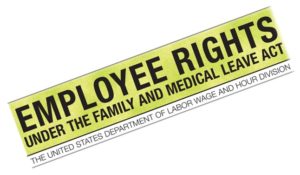The Family and Medical Leave Act is an important law. It’s also a complicated one. The FMLA has a series of procedural steps that both employees and employers must follow. Employees who fail to follow them risk losing the law’s protections (and their jobs). But employers make mistakes too. With that in mind, what are some of the common FMLA violations by employers?

Not recognizing a request for FMLA leave
An employee’s request for FMLA leave triggers several obligations by the employer. For one thing, “the employer must notify the employee of the employee’s eligibility to take FMLA leave within five business days, absent extenuating circumstances.” 29 C.F.R. § 825.300(b)(1). The FMLA imposes several other notice obligations, designed to ensure employees understand their legal rights.
Unfortunately, sometimes employers fail to recognize an employee’s request for family medical leave. Employees don’t need to mention the Family and Medical Leave Act by name to request FMLA leave. All they have to do is give the employer enough information to realize that the employee is asking for time off for a reason covered by the law. For example, an employee who asks for time off to undergo chemotherapy has made a request for FMLA leave, even if the employee doesn’t mention the law by name. An employer who fails to treat the request as one for FMLA and thus doesn’t provide the employee with the proper notices has violated the Act.
How much notice can an employer require for FMLA leave?
Another common FMLA violation by employers concerns the amount of advance notice an employee must give before taking leave. In general, employers can require employees seeking FMLA to follow normal call-off procedures. But in the case of an emergency need for leave, the rules are different. When an employee has an unforeseeable need for FMLA leave, the employer must make exceptions to its notice requirements for “unusual circumstances.” 29 C.F.R. § 825.303(c). So although an employer might require employees to call off at least one hour before work begins, it would need to make an exception for an employee who couldn’t call on time because she was getting emergency medical treatment. In those situations, employees need only give notice to the employer as soon “as practicable under the facts and circumstances of the particular case.” 29 C.F.R. § 825.300(a).
Counting FMLA absences against employees
The whole point of the FMLA is to give employees job-protected leave. That means employers can’t use FMLA leave against employees. One of the most common FMLA violations by employers is counting protected FMLA absences against employees under an attendance policy. That is an FMLA violation, even for employers with a “no fault” attendance policy. It would also violate the FMLA for an employer to punish an employee for not meeting performance quotas while they were out on leave.
Not returning employees to their jobs after FMLA leave
An employee who takes leave has the right to return “to the same position” the employee had when leave started “or to an equivalent position with equivalent benefits, pay, and other terms and conditions of employment.” 29 C.F.R. § 825.214. That is true even if the employer temporarily replaced the employee while on leave. There are several exceptions, but they are limited to very specific circumstances–for instance, if the employer can prove it would have laid off the employee regardless of her need for FMLA leave. 29 C.F.R. § 825.216(a). Outside those exceptions, employers must put employees returning from FMLA back into their old jobs or an equivalent one.
Requiring employees to work while on family medical leave
Employers may not “interfere with” an employee’s protected FMLA leave. 29 U.S.C. § 2615(a). That means an employer can’t make an employee work while on leave, because then the employee isn’t truly getting the benefit of “leave” at all. Although employers may periodically contact an employee on leave for legitimate business purposes here and there, asking too much of an employee on leave is an FMLA violation by an employer. Where the line is depends on the facts of a given situation.
Ignoring the ADA is a common FMLA violation by employers
This is the big one. The FMLA gives 12 weeks of job-protected leave. One of the most common FMLA violations by employers is assuming that once the FMLA expires, they can fire employees who don’t immediately return. That isn’t always the case. As we have written about before, the Americans with Disabilities Act (and Ohio law) sometimes require employers to extent protected medical leave as a reasonable accommodation of a disability. Employers need not give open-ended leave, but if an employee is on leave for a disability, she might be entitled to a brief period of additional medical leave.
Not telling employees about their FMLA rights
One final common violation is employers not telling their employees about their FMLA rights at all. Employers who are covered by the FMLA because they have more than 50 employees within 75 miles of a worksite must post a notice about the Family and Medical Leave Act somewhere conspicuous in the workplace. They must also notify new employees of their FMLA rights. Employees who don’t know about their rights won’t be able to assert them. And given how complicated the FMLA can be, the Act requires that employers take these steps to make sure employees have a fair chance to understand what those rights are.
Ohio FMLA Violation Attorney
These are just some of the more common FMLA violations by employers. There are plenty of others, including retaliation against employees who assert their FMLA rights or simply refusing to grant employees leave when they are entitled to it.
Because the FMLA is so complex, employees need someone who knows the law to help them navigate it. If you think your employer violated your FMLA rights in the workplace call the Ohio Family and Medical Leave Act Attorneys at Bolek Besser Glesius for a free consultation.


Leave a Reply